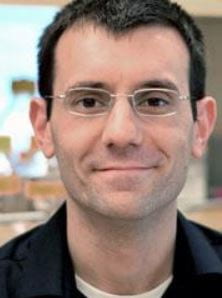Learn more about each of our past Pilot Project Investigators and their projects below:
Pilot Projects 2021-2023
| Mitra Assadi-Khansari, MD Pediatric Neurology Christiana Care Project title: Enhancement of behavioral and cognitive outcomes in autism via neurostimulation Thematic area: Neuroscience Summary: Autism spectrum disorder (ASD) encompasses a wide range of limitations in reciprocal social and communicative milestones, as well as restrictive and/or repetitive patterns of behavior which lead to significant functional challenges impacting individuals throughout their lifespan. The clinical, social and financial burdens of ASD are staggering, and yet, despite the gradual increase in the incidence, the therapeutic alternatives remain extremely limited and ineffective. Moreover, there are no interventions to improve social cognition. Repetitive transcranial magnetic stimulation (rTMS) is a non-invasive neurostimulation technique which alters the cortical excitability by repeated induction of electromagnetic activity. Receiving FDA approval in 2013 for depression, rTMS is a promising tool in the field of neuropsychiatry. The overarching aim of this project is to demonstrate the efficacy rTMS in improving social and cognitive outcomes in ASD by stimulating the mirror neurons populated in the inferior parietal lobule (IPL). |  |
| Carissa Baker-Smith, MD, MPH Dir. of Preventive Cardiology, Division of Cardiology, Department of Cardiovascular Medicine Nemours Project title: Neighborhood Deprivation Index Predicts Loss of Ideal CV Health in Adolescents Thematic area: Cardiovascular Summary: The American Heart Association’s (AHA) “Life’s Simple 7 Metrics” defines ideal cardiovascular health (ICVH) as the presence of 4 health behaviors (healthy diet, regular physical activity, normal body mass index (BMI), never smoked/vaped) and 3 health factors (normal total cholesterol (TC-c), blood pressure (BP) and blood glucose (BG)). In adulthood, ICVH is associated with lower rates of premature cardiovascular disease (CVD). When present at 18 years of age, ICVH is associated with a nearly 70% lower risk of premature CVD. However, most adults do not possess ICVH5 and it is now recognized that CVD begins in youth. Deprivation index (DI), a measure of neighborhood (e.g., NDI) or area deprivation (e.g., ADI) is associated with the loss of ICVH; it is unknown when in life DI impacts CVH status. DI is defined as the low physical, social and economic position of a community. DI plays a key role in the absence of ICVH in adults, but the impact of DI on CVH status in children has not been studied. This project will help to determine if DI is associated with loss of ICVH status during adolescence. |  |
| Roghayeh Barmaki, PhD Assistant Professor Computer and Information Science University of Delaware Website Project title: A new post-stroke upper extremity rehabilitation framework using virtual therapy & robotics Thematic area: Cardiovascular Summary: The objective of the proposed INBRE Pilot is to create and validate a new class of musculoskeletal enhancement and rehabilitation interventions for post-stroke patients with the integration of immersive virtual reality, robotics and wearable smart garments. |  |
| Aditya Dutta, PhD Assistant Professor Animal & Food Sciences / Biological Sciences University of Delaware Website Project Title: Investigating metabolic drivers for precision prevention of prostate cancer Thematic Area: Cancer Summary: This project studies nuclear-mitochondrial communication in prostate cancer from the perspective of mitochondrial metabolism. Specifically, mitochondrial dynamics (mitochondrial fission and fusion) and mitochondrial autophagy (mitophagy) in relation to tumor development. |  |
| Amanda Hernan, PHD Research Scientist, Head of the Dynamics in Epilepsy and Cognitive Development Lab at Nemours, Assistant Professor of Psychological and Brain Sciences University of Delaware Nemours Website Project title: A role for astrocytes in treatment of cognitive deficits after early life seizure Thematic area: Neuroscience Summary: Astrocytes are crucial for the normal development of neurons, are actively involved in neuronal signaling and are crucial for maintaining excitatory/inhibitory balance, and are damaged in adult epilepsy. We have previously shown that ACTH has actions beyond its systemic effects alone in this animal model and may be acting through a subtype of neuropeptide receptors in the brain to improve outcome after recurrent early life seizures (ELS); indeed, very recent preliminary data indicate that ACTH is only effective in animals that express melanocortin 4 receptors (MC4Rs) in the brain. These receptors are on neurons but also astrocytes, one of the most abundant cells in the brain. This project is designed to understand the role of astrocytes and MC4Rs on those astrocytes in altering the way neurons communicate after ELS. |  |
| Hakeem Lawal, PHD Associate Professor Biology Delaware State University Website Project title: Characterizing the Neuroprotective Properties of a Putative Anti-Parkinson’s Thematic area: Neuroscience Summary: The overall goal of this project is to delineate the neuroprotective properties of dacarbazine, a compound that we identified in a previous screen for putative anti-Parkinson disease therapeutics. There is no known cure for Parkinson’s disease (PD) and current drug treatment options are of limited efficacy or induce serious side effects. The work proposed could help advance strategies for the development of effective treatment for PD and possibly point to disease modifying therapies against that disorder. |  |
| Fabrizio Sergi, PHD Assistant Professor Biomedical Engineering University of Delaware Website Project title: Simultaneous TMS and fMRI to study causality of neuromuscular pathways Thematic area: Neuroscience Summary: This project aims to establish causality in the function of the corticospinal and reticulospinal pathways, which serve a fundamental role in post-stroke recovery. This project aims to develop and validate a new methodology, which combines transcranial magnetic stimulation (TMS) with functional magnetic resonance imaging (fMRI) of the brainstem, to study the response of brainstem nuclei during motor responses essential for the control of human movements, the long-latency responses. Our work is enabled by a new MRI-compatible TMS amplifier available at our imaging center, and by our own previous work on the integration of robotics with fMRI to quantify function of the brainstem associated with long-latency responses. If successful, this project will yield the first demonstration of successful combination of TMS and fMRI to study causality of neural function in a distributed motor circuit, involving the primary motor cortex and the brainstem, involved in control of motor tasks. This project will open a new and unique window of observation in the neural substrates of motor impairment and recovery after stroke. Understanding the fundamental neurophysiology of primary and secondary pathways is a necessary step required before applying similar investigations to post-stroke individual. |  |
| Lisha Shao, PhD Assistant Professor Biological Sciences University of Delaware Website Project title: Investigating the genetic and neural mechanisms bridging social stress and reward Thematic area: Neuroscience Summary: The proposed work will gain mechanistic insights into the neural substrates that bridge social environment, stress pathways and the reward circuits and aid in the development of therapeutic treatment and intervention in reward-related disorders associated with social stress. |  |
| Kevin Solomon, PHD Assistant Professor of Chemical & Biomolecular Engineering University of Delaware Website Project title: Barley Stripe Mosaic Virus as an RNA Vaccine Vector for Cancer Immunotherapy Thematic area: Cancer Summary: RNA vaccines have recently emerged as promising cancer immunotherapies for otherwise untreatable cancers. These therapies aim to stimulate macrophages of the immune system to fight tumors marked with antigens encoded in their RNA cargo. The effectiveness of these approaches is substantially improved by vaccine carrier design; carriers must effectively deliver their cargo to antigen-presenting cells and stimulate activation of immune pathways, but not otherwise confer toxicity or deleterious immune responses. Conventional carriers, unfortunately, are limited in their ability to present ligands that stimulate an immune response, may be toxic, or otherwise interact with the immune system in undesirable ways. This project evaluates a novel vaccine carrier based on the plant barley stripe mosaic virus (BSMV) for the delivery of RNA vaccines. The plant-based origins of BSMV promises a lower risk of deleterious immune responses while its well-established design rules allow for unparalleled engineering opportunities to enhance immune activation. More importantly, the RNA promiscuity of BSMV and similar studies with other plant virus suggest a high capacity for the delivery of RNA payloads. |  |
| Shubhika Srivastava, MD Pediatric cardiologist, Chief of the Cardiology Department Nemours Project title: Development of a risk stratification tool to identify role of cardiovascular involvement in children and young adults following SARS-COV2 infection and or exposure Thematic area: Cardiovascular Summary: Severe acute respiratory syndrome coronavirus 2 (SARS‐CoV2) is spreading all over the world and poses a great threat to humans. Its impact on children and young adults has been evolving. Reports of cardiovascular involvement range from asymptomatic to those severely impacted directly by the virus or suffer consequences of a multi systemic inflammatory response that can affect the heart (MIS-C) and other organ systems. Early and long-term sequelae continue to be defined. Existing comorbidities, race and ethnicity and age impact the prevalence of cardiac involvement. There is paucity of data regarding cardiovascular involvement in COVID -19 in children. This makes management decisions difficult especially when clearing children and young adults for sports participation. Approximately 35 to 45 million youth 6 to 18 years of age participate in some form of athletics. With reopening of schools and variable infection rates, the actual burden of COVID -19 infection and its impact on this population (10 years- 30 years age) is unclear as is utilization of cardiovascular testing. Our objective is to build a risk stratification tool specific for patients positive for COVID19 based on a large data enclave representative of the population who tested positive for COVID -19; the National COVID database (N3C). |  |
| Murali Temburni, PHD Associate Professor Delaware State University Project title: Role of astrocytic GPCR pathways in the development of synchronous activity of neurons in culture Thematic area: Neuroscience Summary: The central hypothesis of this project is that during development signaling between astrocytes and neurons is crucial for the establishment of synchronously oscillating neuronal networks. Our preliminary results using the developing chick embryonic brain as a model system indicate that astrocytes are necessary for synchronous activity of neurons in culture. We have developed a model in which astrocytic G Protein Coupled Receptors (GPCR) sense neurotransmitter, elevate intracellular Ca++ flux and in turn release “gliotransmitters” like glutamate and ATP. We implicate the metabotropic glutamate receptor (mGluR), the purinergic P2Y1 GPCR and the metabotropic GABA-B receptor in the development of neuronal synchrony. For this project, we will test the astrocytic GPCR model bidirectionally – by activating the pathway with optogenetics using melanopsin, a light activated photopigment and blocking the other two GPCR pathways (P2Y1 and GABA-B) with dominant negative proteins). |  |
| Elizabeth Wright-Jin, MD Pediatric Neurologist Nemours Project title: Sex and microglia in neonatal hypoxic ischemic brain injury Thematic area: Neuroscience Summary: Hypoxic ischemic injury is a leading cause of cerebral palsy in infants born at term gestation. Children who sustain these injuries early in life can be left with debilitating cognitive and motor deficits. Therapeutic hypothermia has reduced the incidence and severity of these injuries, however, many children develop cerebral palsy and intellectual disability despite this treatment or do not receive this treatment within the short time window it must be initiated after birth. Notably, boys have a higher likelihood of developing cerebral palsy than girls. Animal studies have begun to reveal sex-specific responses to neonatal brain injury may underlie this increased risk in males. Microglia, the primary immune cell in the brain, have a major role in sexually dimorphic brain development; and given their central role in response to brain injury, microglia may influence this discordant outcome. This project will investigate the influence of sex on microglia response after neonatal hypoxic ischemic injury. |  |
| Xuyi Yue, PhD Clinical Research Scientist Nemours Website Project title: Neurofibromatosis Type 1 Imaging Using a Fluorine-18 Labeled Tryptophan Tracer Thematic area: Neuroscience Summary: This project aims to address the challenges in accurate diagnosis, monitoring, and posttreatment evaluation of malignant peripheral nerve sheath tumors (MPNSTs) which contribute to dismal prognosis, we propose to use a novel fluorine-18 labeled tryptophan positron emission tomography (PET) radiotracer to detect and differentiate Neurofibromatosis type 1 (NF1) in an animal model. The imaging results will be correlated with western blot, immunohistostaining, and histopathology findings, and to identify the diagnostic and theranostic biomarker for NF1. |  |
Pilot Projects 2019-2021
| Anjana Bhat, PhD Associate Professor, Physical Therapy University of Delaware Project title: A multisystem, multimodal intervention for children with ASD Thematic area: Neuroscience Summary: We propose to examine effects of an 8-week novel synchronous, multisystem, multimodal play intervention to facilitate social communication and motor skills of children with Autism Spectrum Disorder (ASD). Our preliminary studies showed that practicing musical synchrony as a group led to highest levels of social attention and increase in amount of social verbalization as well as an increase in imitation accuracy and percent of interpersonal synchrony following 8 weeks of intervention compared to a sedentary play group. While we are encouraged by the positive behavioral findings, we still do not know the neural mechanisms that facilitate social communication skills when children engage in socially embedded, synchronous whole body movements. |  |
| Elise Corbin, PhD Assistant Professor , Biomedical Engineering University of Delaware Project title: Mechanical Phenotypes of Sepsis-Induced Cardiomyopathy Theme area: Neuroscience Summary: The long-term goal of this research is to develop an in vitro model of sepsis-induced cardiomyopathy to elucidate fundamental mechanisms of pathology and enable development of effective treatments. Sepsis is a systemic immune response to infection that can have serious consequences including organ dysfunction and mortality. Cardiovascular dysfunction is common in sepsis though the mechanics of this cardiomyopathy is unknown. As such, no existing therapy directly targets intrinsic cardiac injury in sepsis despite extensive evidence of its prevalence, and treatment is currently limited to antimicrobial agents and circulatory support (i.e. vasopressors) applied broadly to patients with a sepsis syndrome. |  |
| Christine Charvet, PhD Assistant Professor, Psychology Delaware State University Website Project title: Translating ages in humans and model organisms across the lifespan Thematic area: Neuroscience Summary: The goal of this project is to identify corresponding ages across postnatal ages in humans and model organisms. This work is needed because scientists often use model organisms such as mice to understand basic biological processes and disorders in humans, but there is currently no resource that enables researchers to find corresponding ages across the lifespan of model organisms and humans. |  |
| Catherine Fromen, PhD Assistant professor, Chemical & Biomolecular Engineering University of Delaware Project title: Aged to perfection: Enhancing survival of antigen presenting cells for cancer therapies Theme area: Cancer Summary: Macrophages and dendritic cells (DCs) are important effector cells of the innate immune system responsible for clearing foreign objects and bridging the innate and adaptive immunity. During lung cancer, both cell types undergo considerable dysfunction and contribute to a protumor environment. Restoration of proper innate immune cell function may enable these cells to combat the cancer and reduce tumor burden, thus both macrophages and DCs represent significant targets for lung cancer therapies. The overall objective of this work is to 1) investigate the mechanism of NP-induced phagocyte longevity and 2) develop a substantial framework for controlling cell viability for lung cancer therapies. |  |
| Jennifer Goldstein, MD Assistant Program Director, Internal Medicine Residency Program, Director of Resident Research Christiana Care Project title: The impact of social determinants of health on medical decision making in diabetes care Thematic area: Cardiovascular Summary: Completion of this research program will be the first step in examining whether and how physicians integrate data related to SDoH into their clinical management plans. Our findings will advance precision medicine by clarifying current practice related to collection of SDoH data and whether it triggers clinical action or inertia among physicians. This will be critical to understanding whether SDoH screening could lead to meaningful clinical changes that could reduce health care disparities. |  |
| Jing Jin, MD Ophthalmologist, Division of Pediatric Ophthalmology, Department of Surgery Nemours, A.I. duPont Hospital for Children Project title: Non-invasive monitoring of sickle cell disease progression via OCT and ERG Thematic area: Cancer Summary: The research proposed in this application will utilize a combination of standard and novel noninvasive diagnostic modalities to examine retinal structure and function in children with SCD. Using these techniques will improve our ability to accurately diagnose and monitor SCR in children and provide a better understanding of the pathophysiology of the disease. Through this study, we will refine our ability to predict progression, assess therapeutic efficacy, develop more effective monitoring guidelines and initiate early interventions. Correlating retinal findings with clinical data may provide insight into other vascular complications of SCD, such as cerebrovascular disease. The long-term goal of this study is to enhance early detection of SCR and develop treatment strategies to slow the progression of SCR toward proliferative retinopathy and blindness, lowering the societal burden of SCR and improving the quality of life for these patients. |  |
| Karl Milletti-Gonzalez, PhD Associate Professor, Biological Sciences Delaware State University Project title: Regulation of oxidative stress by CD44 in triple negative breast cancercells from African American women Thematic area: Cancer Summary: The objective of the proposed study is to investigate a potential underlying molecular mechanism by which CD44 regulates the oxidative stress response via the CD44-ICD in TNBC cells from AA women. Our central hypothesis is that the involvement of CD44 in the oxidative stress response includes 1) protein-DNA interactions between the CD44-ICD and its response element (CIRE) on promoters of NFE2L2 and KEAP1 and 2) protein-protein interactions between Runx2 and/or p53 and the CD44-ICD to regulate the expression of NFE2L2 and the Nrf2 function. This regulatory mechanism is proposed to show differences in TNBC cells from AA women compared to TNBC cells from EA women. |  |
| Jeffrey Mugridge, PhD Assistant Professor, Chemistry & Biochemistry University of Delaware Project title: Selectivity and function of RNA demethylase FTO: from structure to glioblastoma Thematic area: Cancer Summary:This project will use structural studies to understand how FTO recognizes m6Am modifications on the mRNA 5′ cap and biochemically dissect FTO m6A versus m6Am selectivity in vitro and in glioblastoma models. Metastable intermediates that arise during FTO-mediated demethylation will also be leveraged to develop aptamer-based probes that can directly bind and capture RNA at the site of demethylation. These tools can later be used in sequencing applications to map FTO-mediated RNA demethylation in cellular mRNA. |  |
| Rahul Nikam, MD Radiologist/Assistant Professor of Radiology & Pediatrics Nemours / A.I. duPont Hospital for Children Project title: Magnetic Resonance Elastography in Characterization of Pediatric Gliomas Thematic area: Neuroscience Summary: In this project we intend to bridge the gap between the various grades and genetic subtypes of pediatric glimoa, and MRE derived viscoelastic mechanical properties. There are no studies done in pediatric brain tumor population evaluating the relationship of tumor stiffness with tumor grade, genetic alterations and proliferation index. |  |
Pilot Projects 2016-2018
| Team #1 | |
| Sonali Barwe, PhD Research Scientist Nemours/Alfred I. duPont Hospital for Children Project title: The role of epigenetic therapy in reversing adhesion mediated drug resistance in leukemia. Thematic area: Cancer Summary: Acute lymphoblastic leukemia ALL is the most common pediatric leukemia. Although most patients are cured, about 20 percent relapse because of drug-resistant leukemic cells retained within the bone marrow. This study aims to establish the use of epigenetic therapy for treatment of all relapsed ALL. The data also will aid in detection and prediction of clinical response to epigenetic therapy. |  |
| Anilkumar Gopalakrishnapillai, PhD Assistant Research Scientist II Nemours/Alfred I. duPont Hospital for Children Nemours Biomedical Research Project title: Deciphering the mechanism of Down syndrome leukemia (DS-AML) biogenesis using isogenic iPSC lines and CRISPR/Cas9 technology Thematic area: Cancer Summary: The goal of this study is to identify key targets involved in the development of acute myeloid leukemia in children with Down syndrome (DS-AML). Currently, no targeted therapeutics are available for this disease to avoid toxic side-effects from chemotherapy. When completed, this study will aid in developing targeted therapy against DS-AML. |  |
| Team #2 | |
| Shirin Modarai, PhD Junior Research Scientist Christiana Care Center for Translational Cancer Research/Helen F. Graham Cancer Center and Research Institute Thematic area: Cancer Summary: Colorectal cancer (CRC) is the third-leading cancer for men and women in the United States. Tumor formation and growth is thought to occur due to stem cell overpopulation. Current anti-cancer therapies can sometimes shrink tumors by killing the rapidly proliferating cells, but since cancer stem cells (CSCs) are not typically actively dividing, they are not targeted during the development and use of chemotherapeutic drugs. This may explain why there is such a high rate of disease recurrence for most cancers. Since CSCs are responsible for driving tumor growth it is critical to find markers that can identify these cells and eliminate them from the tumor. Aldehyde dehydrogenase (ALDH) is a reliable biological marker. The proposed project aims to identify a specific sub-population of ALDH+CSCs that leads to stem cell overpopulation and ultimately will lead to more innovative anticancer targeted therapies. | |
| Cheng-Yu Lai, PhD Associate Professor, Chemistry Delaware State University Project: Targeted Nanoparticles to Deliver APC Tumor Suppressor Protein for Treatment of Colon Cancer Theme area: Cancer Summary: Successful demonstration of intracellular APC protein delivery that leads to restoring homeostasis in colorectal cancer will create the foundation for a novel targeted protein therapy of colon cancer. |  |
| Individual Pilot Projects | |
| Lisa Jaremka, PhD Assistant professor, Psychological and Brain Sciences University of Delaware Project: Appetite Regulation and Food Intake: Novel Mechanisms Linking Marital Distress to Cardiovascular Risk Theme area: Cardiovascular Summary: Cardiovascular disease (CVD) is the leading cause of death in the United States and worldwide. Medical costs associated with treating CVD-related problems are estimated at $315.4 billion per year in the US alone. Distressed marriages are a reliable risk factor for the development and progression of cardiovascular problems. This project will provide novel information about appetite dysregulation and increased food intake as mechanisms that underlie the link between marital distress and cardiovascular risk. Ultimately, these data could provide important targets for focused interventions that would help prevent cardiovascular problems from developing. |  |
| Susanne Morton, PhD Associate professor, Physical Therapy University of Delaware Project: Noninvasive Brain Stimulation to Improve Motor Learning Post-Stroke Thematic area: Neuroscience Summary: Stroke is a leading cause of serious long-term disability for which the only treatment is physical rehabilitation. During rehabilitation, stroke patients must learn or relearn movements that have been lost due to damage to the motor regions of the brain. Unfortunately, motor learning after stroke is often poor. In this project, we will test whether non-invasive brain stimulation in the form of transcranial direct current stimulation (tDCS) improves motor learning after stroke and we will determine if tDCS works on motor learning by temporarily increasing brain excitability. Findings will lead to important advancements in motor learning-based interventions to improve motor recovery for people with stroke. |  |
| Jessica Tanis, PhD Assistant professor, Biological Sciences University of Delaware Project: Role of the CLHM-1 ion channel in C. elegans neurons Thematic area: Neuroscience Summary: More than 5 million Americans live with Alzheimer’s disease, a neurodegenerative brain disorder that causes dementia in elderly individuals. It is important to understand the factors that contribute to AD pathogenesis. The P86L polymorphism in Calcium homeostasis modulator 1 (CALHM1) influences Alzheimer’s disease age of onset. CALHM1 knockout mice exhibit a significant increase in the steady state levels of amyloid beta, a causative factor in Alzheimer’s disease. However, the physiological function of CALHM1 in the brain remains unclear. CALHM1 and its C. elegans homolog CLHM-1 have been shown to belong to a new family of ion channels that exhibit shared biophysical properties when expressed in heterologous systems and functional conservation when expressed in C. elegans. The goal of our research is to use the C. elegans model system to determine how the activation and regulation of CALHM channels alters neuronal signaling in vivo. |  |
| Erik Thostenson Associate Professor, Mechanical Engineering University of Delaware Project: Novel Flexible Sensors in Functional Fabrics for Performance Monitoring Thematic area: Neuroscience Summary: People with movement difficulties use significantly different joint postures to achieve activities of daily living, which may be larger or smaller than their neurologically healthy counterparts. By monitoring everyday movement of a particular limb outside a laboratory setting, the opportunity exists to provide feedback or intervention to enhance function and improve quality of life.This pilot project aims to create and validate a new class of novel flexible sensors for integration in functional garments capable of measuring joint motions and forces during daily living. |  |
| Christopher Modlesky University of Delaware Project: High-Frequency, low-magnitude vibration, muscle performance and physical activity in children with cerebral palsy | |
| Clytrice Waterson Delaware State University | |
| Integrated Team Research Project The integrated research team involves multiple pilot investigators working under a senior investigator to develop a multidisciplinary team across different institutions. | |
| Project: Relationships between hgh-frequency, low-magnitude vibration (HLV) treatment and improvement in brain and muscle structure and functional outcomes measures in children with cerebral palsy Thematic area: Neuroscience Mentor: Stuart A. Binder-Macleod, PhD Summary: Cerebral palsy (CP) is a neuromuscular disorder that affects about 800,000 people in the United States. Muscle spasticity, low muscle volume, strength and quality, poor balance and increased risk of falls stem from an injury to the brain that impairs postural control and mobility. The result is a reduction in physical activity which is strongly linked to obesity and a high risk of chronic disease. Our long-term goal is to identify treatments that facilitate optimal development of the neuromuscular system, increase participation in physical activity, and reduce the risk of chronic disease in children with CP. One treatment that has received significant attention is high-frequency, low-magnitude vibration (HLV); however, studies examining the effect of HLV on neuromuscular performance and physical activity in children with CP are lacking. Jeremy Crenshaw Assistant Professor, Kinesiology and Applied Physiology University of Delaware Project: Development of a comprehensive evaluation of postural control in children with cerebral palsy Summary: Falls are common in children with CP, often leading to serious injury and a fear of falling. In turn, physical activity is limited. The cumulative effects of inactivity translates into a higher risk for cardiometabolic disease. A comprehensive assessment of postural control will allow us to evaluate the benefits of interventions to improve motor function and increase physical activity in this population. The overall objective of this application is to develop a comprehensive framework to investigate the benefits of HLV treatment on postural control and physical activity patients with CP. Curtis Johnson Assistant professor, Biomedical Engineering University of Delaware Project: High-resolution brain MR elastography in children with cerebral palsy Summary: The overwhelming majority of children with CP exhibit some form of white matter or gray matter damage that is ostensibly related to the clinical disability observed in CP. As rehabilitative therapies aim to improve physical function through neuroplastic recovery of brain health, it is important to employ an imaging method for characterizing neural damage and recovery. The objective of this research is to develop magnetic resonance elastography (MRE) methods to determine if there is a loss of brain tissue viscoelasticity in CP. We will compare brain tissue viscoelasticity in children with CP with that of typically developing (TD) children. We will also assess the physical function of children with CP and establish relationships between brain tissue viscoelasticity and functional out measures. The use of this method can have a profound impact on individualized treatment and care for children with cerebral palsy. | |
| Pilot Projects 2014-2016 | |
| Noureddine Melikechi, PhD Delaware State University | |
| Michael Gitcho, PhD Delaware State University Neuronal and Glial expression of TDP-43 in Alzheimer’s Disease The greatest risk factor for Alzheimer’s disease is aging. About 5.3 million people aged 65 and older are estimated to live with the disease. Baby boomers will add an additional 10 million cases in the next decade. For those with Alzheimer’s disease there is an increase in plaque deposition that accelerates memory loss. The major pathological protein in frontotemporal dementia and motor neuron disease is TDP-43, which was recently found to be present in up to 50 percent of Alzheimer’s disease cases. Dr. Gitcho’s pilot project investigates what cell types are responsible for this age-related increase in pathology. Understanding the mechanisms associated with these changes and also how age contributes could improve understanding about the progression of Alzheimer’s disease. This mouse model potentially could lead to the development of new therapeutics targeted at slowing the progression. |  |
| Anilkumar Gopalakrishnapillai, PhD Nemours Metformin as adjuvant therapy to prevent relapse in pediatric acute myeloid leukemia Acute myeloid leukemia, or AML, accounts for 15 to 20 percent of childhood leukemias. Although the majority of kids achieve remission with the existing chemotherapy treatment, half suffer a return of the disease. Therefore, drugs that can prolong disease-free stage are needed. Metformin is a widely used anti-diabetic drug that is known to show anti-cancerous effect in several cancer types. It is safe and non-toxic but, because of the lack of preclinical data, its inclusion in the treatment regimen of pediatric cancer, especially AML, is difficult to justify. Dr. Gopalakrishnapillai’s pilot project aims to fill this gap by providing preclinical basis for the use of metformin to supplement existing chemotherapy. This study will also help researchers understand how metformin kills AML cells. |  |
| Shannon Lennon, PhD University of Delaware Vascular Effects of Dietary Potassium in Humans Hypertension is linked to the development of multiple kinds of cardiovascular disease in the United States. Dietary sodium restriction is an important lifestyle modification for people with hypertension, but it appears to have detrimental effects on vascular health independent of changes in blood pressure. While sodium can increase blood pressure, potassium has been shown to be protective and to lower blood pressure in those with hypertension. Dr. Lennon-Edwards’ pilot project will use a controlled dietary study approach comparing the effects of high-sodium diets combined with either high or moderate levels of potassium on two levels of the vasculature, conduit and microvasculature. These studies will be performed in salt-resistant adults to study the vascular effects independent of changes in blood pressure. |  |
| Qi Lu, PhD Delaware State University Evaluating the Effects of Nanoparticles on the Packing and Organization of Lipid Domains The goal of this study is to make clear the impact of nanoparticles on the structural organization in lipid domains in order to evaluate the potential of using these microscopic particles in preventing cancer invasion and metastasis. Lipid rafts are floating membrane microdomains enriched in cholesterol and sphingolipids that float in the liquid-disordered phase of cellular membranes. They serve as platforms for the nanoscale assembly of membrane proteins. The modulation of malignant phenotype of cancer cells in terms of cancer cell adhesion, aggressive invasion and metastatic spread is mediated, to a large extent, by lipid rafts. On the other hand, silver nanoparticles, or NPs, were observed to cause the structural reorganizations of lipid vesicle bilayers and lead to an enhanced fluidization in vesicles. Dr. Lu’s project intends to evaluate the potential of using NPs in cancer prevention and therapy in regard to the mechanism of cancer invasion and metastasis. |  |
| Michael McCulloch, MD Nemours Data Driven Mathematical Modeling of the Hypoplastic Left Heart Syndrome Circulation Dr. McCulloch is a board-certified pediatric cardiologist with a passionate interest in the complex physiology and anatomy of newborns with hypoplastic left heart syndrome. The congenital condition – also known as HLHS – occurs when parts of the left side of the heart do not develop completely. It is the most common congenital heart defect resulting in death. He proposes to produce first mathematical model of the HLHS anatomy and physiology to help answer questions about the reasons for the high mortality rate for these patients. Even with treatment, patients face a 30 percent one-year mortality rate. This mathematical model will focus on determining the answer using bedside vital sign data. Through three separate but interrelated methods, Dr. McCulloch and his team aim to produce a model capable of predicting impending periods of hemodynamic instability on an individualized patient basis. If successful, this approach could change the mortality rate for this fragile patient population by providing instantaneous, continuous feedback on a patient’s clinical status. |  |
| Thomas Planchon, PhD Delaware State University Adaptive Bessel Light-Sheet Flourescence Microscope (AB-LSM) for Live-Cell Imaging Dr. Planchon’s research focuses on developing novel optical imaging technologies to enable discoveries in the field of biological sciences at large. His INBRE pilot project aims at developing a novel optical microscope, specifically addressing a need in imaging of live cells and live biological specimens. Scientists often encounter a critical barrier while looking at specimens – the cell or organism under observation eventually dies off from light exposure, a process known as phototoxicity. Planchon’s research proposes to create a microscope that can film live specimens without killing them. The tool, called the Adaptive Bessel Light-Sheet microscope, gets its low toxicity by using a computer-controlled liquid crystal device to generate the thinnest light-sheet possible – 100 times thinner than the width of an average human hair. This imaging technique method could be used in cancer, cardiovascular or neuroscience – the three research areas under Delaware INBRE. |  |
| David Pokrajac, PhD Delaware State University Improving Realism of Software Breast Phantoms Breast cancer is the most common cancer among American women, except for skin cancers, and the second leading cause of cancer death. Continuous improvement and innovation of affordable medical imaging systems that can provide high-sensitivity and high specificity breast cancer screening is essential to decrease the burden of cancer on public health. Dr. Pokrajac’s project addresses the need to speed up the translation of breast imaging research to clinical reality by improving the quality of preclinical validation of novel imaging systems. Motivated by the need to increase the realism of software breast phantoms – which offer flexibility to simulate anatomic variations and provide ground truth for simulated tissue structures – he proposes to develop novel simulation algorithms, obtain the optimal values of phantom parameters and validate the approach using simulated and clinical images. He will determine optimal values of phantom parameters using histologic imaging and segmentation of reconstructed mastectomy computed tomography data. The simulated images will be validated by comparison to the clinical images through objective and subjective validation. The ultimate goal of the proposed modification is to set the foundation for a larger-scale NIH funded projects on the extension of breast imaging simulation to digital breast pathology | |
| Rhonda Prisby, PhD University of Delaware Characterization of Bone Marrow Microvascular Ossification in Rodent and Human Long Bones Vascular origins of bone diseases like osteoporosis are poorly understood and understudied. Dr. Prisby has discovered severe calcification of bone marrow blood vessels in a rodent model of aging. Her pilot project seeks to address the consequence associated with bone marrow blood vessel ossification by characterizing the development and progression of the pathology as a function of age. If such pathology is evident in the human skeletal system, results would perhaps provide some explanation for the development of bone disease and the complications associated with poor fracture healing with advanced age. Successful completion of this project could provide paradigm-shifting causes of bone disease, which are vascular in nature, and aid in understanding the development, progression and the inefficacies of pharmaceutical treatment in bone disease |  |
| Regina Sims Wright, PhD University of Delaware Diet Quality, Inflammation, and Cognition: An Analysis of the HANDLS Study Poor diet quality is a significant predictor of cardiovascular disease, the top cause of death in the U.S. It also has been linked to cognitive difficulties, and growing evidence suggests inflammation is the primary pathway of influence. No studies have examined how individual components of diet quality influence these complex associations. Moreover, none have examined this association in a racially diverse sample, which is problematic because poor diet quality is more common among African Americans as compared to whites, in part because of socioeconomic and cultural barriers. Dr. Sims Wright plans to use data from the Healthy Aging in Neighborhoods of Diversity across the Life Span study, or HANDLS, to disentangle the mechanisms linking diet quality to cognitive function through inflammatory pathways. Her research aims to make a meaningful contribution toward understanding the roles of numerous components of the diet to inflammatory and cardiovascular pathways that may contribute to cognitive decrements and how these pathways may vary as a function of race. |  |
| Jennifer Sims-Mourtada, PhD Christiana Care Health System Molecular Mechanisms to Distinguish Aggressive Tumors A large proportion of prostate tumors occur as indolent tumors that are clinically insignificant. But a minority these are fast growing, malignant cancers that need significant clinical intervention. Currently, the molecular mechanisms to distinguish indolent from aggressive tumors is unknown. Dr. Sims-Mourtada’s project proposes that these aggressive tumors “prepare the soil” of the metastatic microenvironment by increasing the sensitivity of bone marrow stromal cells to factors secreted by tumor cells. Her project examines the role of stromal primary cilia – which are non-moving structures that serve as beacons for cellular signaling – on growth and survival of prostate cancer cells. She hopes to determine if localization of hedgehog signaling components – a factor that binds to receptors on the cilia – promotes survival of prostate cancer cells. |  |
| John H. Slater, PhD University of Delaware Modular Arrays of Vascularized Multi-Cellular Micro-Tissue Constructs for High-Throughput Drug Screening The delivery of new marketplace therapeutics for the treatment of cardiovascular disease and cancer is hampered by two challenges: the high cost of new drug development and a high failure rate. The average expenditure to introduce a new drug is $802 million, with some reaching $5.5 billion. But the level of risk for a company to generate a new therapeutic could be lowered through the use of more physiologically relevant in vitro screening models and lead to an increased selection of disease‐specific therapeutics with increased efficacy. Three‐dimensional cell culture systems that more closely replicate the physiological conditions encountered by cells in vivo are being developed. These systems are anticipated to serve as better preliminary screening models with the potential to replace animal models in the future. Dr. Slater’s work in his pilot project outlines a methodology to address one of the major limitations with current three-dimensional cell culture platforms: the ability to create highly vascularized fluidic systems embedded in synthetic matrices for nutrient delivery and waste removal. |  |
| Megan W. Wenner, PhD University of Delaware Reproductive Aging and Vascular Function Cardiovascular disease is the leading cause of death in women. Young women are generally thought to be protected because of the vaso-protective effects of estrogen. But there is a decline in estrogen as women transition to menopause. Postmenopausal women have impaired vascular function that can be reversed by estradiol therapy. Recently, there has been controversy regarding the safety and efficacy of hormone therapy in menopausal and postmenopausal women, specifically questioning whether estradiol therapy offers cardio-protection to these women. The ‘timing hypothesis’ suggests that starting hormone therapy early in the menopausal transition – before atherosclerotic disease is present – can offer cardio-protection and help alleviate menopausal symptoms such as hot flashes. Dr. Wenner’s project is investigating the effects of reproductive age and estradiol on ET-1 mediated microvascular vasoconstrictor function in peri-menopausal women. ET-1, or endothelin-1, is a potent vasoconstrictor that has been implicated in the development of atherosclerosis. Functional changes in the microcirculation can be used as an index of future cardiovascular disease risk. |  |
INBRE II Pilot Investigators
| Jingyi Yu 2012-2014 University of Delaware Project: iSurg: An immersive surgery training system using emerging 3D imaging and display technologies | |
| Bryan Wakefield 2012-2014 Delaware State University | |
| Thomas Smolinski 2012-2014 Delaware State University Project: NeRvolver: A System for Automated Construction and Tuning of Neuronal Models | |
| Darcy Reisman 2012-2014 University of Delaware Project: Motor Learning After a Stroke | |
| Mukti Rana 2012-2014 Delaware State University Project: Development of nanofiber membrane in situ electroporation devices for pharmacogenomics anticancer drug screening | |
| Li Liao 2012-2014 University of Delaware Project: New Probabilistic Models for Protein Sequences | |
| Sigrid Langhans 2012-2014 Nemours Children’s Hospital Project: Defining the role of Sonic hedgehog mediated regulation of Na, K-ATPase in meduloblastoma | |
| Christopher Knight 2012-2014 University of Delaware School of Nursing Project: Motor Unit Discharge and Slowed Motor Output in Elderly Summary: The elderly are often frustrated by poor control during precision tasks, and slower production of muscular force has specific importance in fall prevention. Motor unit research is in dire need of expanded paradigms to provide new information about control mechanisms during real-world tasks. We will examine age-related differences in two relevant motor unit discharge behaviors and provide information that can be used to improve movement quality in older adults and also in patient populations. Aim 1 is about rate coding during the precise control of sinusoidal isometric contractions. It is hypothesized that that the amplitude of firing rate modulation is less in older adults, perhaps due to enhanced twitch summation of aged muscle fibers with slowed contractility. Aim 2 is about motor unit discharge behavior during rapid force production from rest as well as from a submaximal force level. It is hypothesized that during the initiation of rapid contractions, the initial firing rates of aged motor units will be slower and there will be fewer doublet discharges, as compared to young adults. Motor unit and muscular force recordings, surface electromyography and contractile properties will be obtained from the first dorsal interosseous muscle of 20 young (<30 years) and 20 older (>65 years) adults. Successful experiments in these conditions can be considered significant progress in motor unit research. In addition to furthering knowledge of normal aging at the level of the motor unit, this project will provide vast new information about motor unit discharge behavior in general. Consider for example: 1) the value of this normative data for similar research in patient populations, and 2) a better knowledge of neural commands in healthy individuals can help to improve the functional electrical stimulation of paralyzed muscle. This project also provides the basis for future research on the adaptability of these neural factors and function in older adults and patient populations. | |
| Deborah Ehrenthal 2012-2014 ChristianaCare Project: Cardiovascular risk one year following a pregnancy complicated by hypertension | |
| Hacene Boukari 2012-2014 Delaware State University Project: Kinetic mechanisms of the viscoelasticity of pathogenic sickle cell hemoglobin polymers | |
| Sonali Barwe 2012-2014 Nemours Children’s Hospital Project: Inhibitors of annexin II tetramer/annexin II receptor axis as potential therapeutics for pediatric acute mymphoblastic leukemia relapse | |
| Michael McCulloch 2013-2014 Nemours Children’s Hospital Project: Computer Simulation of the Single Ventricle Anatomy and Physiology Examining Mechanisms for Sudden Cardiac Death | |
| David Edwards 2010-2012 University of Delaware College of Health Sciences Project: Endothelial Progenitor Cell Function in Chronic Kidney Disease | |
| Claudine Jurkovitz 2010-2012 ChristianaCare Project: Effect of Kidney Function on the Association Between Obesity and Cardiovascular Events | |
| Paula Klemm 2010-2012 University of Delaware School of Nursing Project: A pilot study of predictors of intensive exercise among college students. | |
| Raelene Maser 2010-2012 University of Delaware Health Sciences Project: Effect of Renin Inhibition on Cardiovascular Autonomic Nerve Function in Diabetes | |
| Mary McClane 2010-2012 University of Delaware Health Sciences Project: Direct Interaction of Eristostatin with Melanoma Cell Surface Molecules | |
| Thomas Mennella 2010-2012 Delaware State University Project: The Role of the H2A.Z Histone Variant in Reactivating Tup1-Repressed | |
| Steven Most 2010-2012 University of Delaware Psychological and Brain Sciences Project: Neuro-Cognitive Self-Regulation Mechanisms and Their Relation to Obesity Summary: The proposed research will investigate whether individuals struggling with weight management exhibit characteristic neuro-cognitive indices related to attentional- and self-control and because intervention often involves effortful implementation of sustained lifestyle changes whether such indices might additionally predict intervention outcomes within a population of such individuals. The following are among the questions to be tested: (1) Do individuals struggling with weight management exhibit marked impulsiveness or difficulties involving attention shifting, working memory, and the inhibition of otherwise reflexive behaviors? Do such indices correlate with objective measures such as BMI and efficacy of intervention over the course of treatment? (2) Are weight management problems accompanied by exaggerated affectively-driven neural responses to food cues and/or by a relative inability to regulate such responses? (3) Do common food cues, such as appetitive aromas generally negatively impact cognitive control functions? These issues will be investigated through the use of objective and proven neuro-physiological and behavioral methods. It is anticipated that data obtained in the initial stages of investigation will set the stage for future funding and research, as well as for building further bridges between the University of Delaware, the A.I duPont Hospital for Children, and INBRE core centers at the Delaware Biotechnology Institute. Furthermore, this project will provide a unique training opportunity for undergraduate and graduate students wishing to work at the interface between clinical and neuro-cognitive research. | |
| Sharyn Rossie 2010-2012 Nemours Children’s Hospital | |
| Krishna Sarker 2010-2012 University of Delaware Biological Sciences Project: Calcium and Integrin-Binding Protein 1 (CIB1) in Cancer Cell Invasion Project Summary: Cancer is one of the leading causes of death of all mankind. Cancer cells not only display uncontrolled proliferation, but also develop the ability to migrate from their original site to other organs in the body. This event is known as metastasis, the hallmark of malignant cancers. During metastasis, cancer cells break numerous barriers to travel through the body’s circulatory system and invade other organs to form secondary tumors. Therefore, it is important to understand, the underlying mechanism of cancer metastasis to find a cure for cancer. Integrins, membrane protein receptors for extracellular matrix proteins, have been implicated in cancer cell proliferation and metastasis. In addition, focal adhesion kianse (FAK) has been shown to be pivotal for cell adhesion and migration. However, the involvement of effector molecules which lie in the integrin and FAK mediated signaling pathway is largely unknown. Our lab recently discovered an ubiquitously expressed calcium and integrin-binding protein 1 (CIB1) which interacts with a number of cellular proteins, including platelet specific integrin. Further, CIB1 also interacts and co-localizes with FAK at the membraneous extensions and has been implicated in cell spreading and migration. The role of CIB1 in a pathophysiological condition such as cancer remains to be elucidated. Our preliminary results show that CIB1 expression is significantly increased in breast cancer tissue compared to normal breast tissue. Overexpression of CIB1 in T47D cells, breast epithelial cell line, showed increased cell migration on collagen matrix as determined by a trans-well migration assay. When endogenous CIB1 was knocked down in T47D cells using siRNA, cell migration was significantly decreased. A decreased tyrosine phosphorylation of FAK was also observed in CIB1 knocked down T47D cells compared to mock transfected cells as determined by Western blot analysis, demonstrating that CIB1 may mediate cancer cell migration by enhancing phosphorylation of FAK. The goal of the present study is to have better insights of CIB1’s role in cancer cell invasion leading to metastasis. This will be achieved by determining the relationship of CIB1 expression and invasive behavior of the breast cancer cells in vitro and vivo and by elucidating the signaling pathways that CIB1 regulates in order to dictate the invasive behavior of breast cancer cells. We believe that our study will give a better understanding of the role of CIB1 in cancer cell invasion. It will also identify a novel cellular target for therapeutic intervention of breast cancer. Further, a clearer understanding of this process will provide a basis for developing effective therapies for this most lethal aspect of breast cancer. | |
| Wenlan Wang 2010-2012 Nemours Children’s Hospital Project: Systematic analyses of SMN complexes in motor neurons | |
| Robert Akins 2010-2012 Nemours Children’s Hospital Project: Biomaterials for Cardiovascular Tissue Engineering Summary: The engineering of cardiovascular (CV) grafts that mimic the properties of native tissue remains a formidable research and clinical challenge and a principal area for translational research emphasis. In particular, controlling the organization of cells in engineered tissues is a critical issue, and there is a important and well-recognized need to identify physical and molecular pathways that can be manipulated to direct the formation of desirable constructs. Unfortunately, little is known about (i) the types of physical substrates that might be most effective in guiding multi-cellular assembly, (ii) the cellular mechanisms that drive the formation of integrated structures ex vivo, and (iii) the effects of organizational strategies on the component cells of engineered tissues. With this application, we seek initial funds for a new interdisciplinary research program to address these areas within the context of developing critically-needed implants to treat congenital and acquired CV disease. Mammalian CV systems are essentially closed, fluid-filled networks of conduits that contain varying degrees of muscle to control luminal volume and restrict or generate flow. Implantable biosynthetic conduits that reproduce essential CV functions would be valuable for the treatment of adult disease but are also uniquely suited for the repair of pediatric defects. Indeed, CV tissue engineering will offer opportunities for the growth and remodeling of implants while minimizing thrombogenesis and intimal hyperplasia and providing for appropriate physiologic responsiveness and graft self-renewal over the lifetime of the implant recipient. Our long-term goal is the development of composite ves-sels (see Figure 1) with bio-synthetic components that act initially as scaffolds to provide mechanical support while recruiting the appropriate cellular/biological components but that later degrade leaving a completely biologic vessel. The development of such implants will require advances in multiple areas including, 3D fabrication technologies, molecular and physical mechanisms to control cell distribution and function, and evaluating interactions between scaffold materials, cells, and the host physiology. Once fully developed, envisioned applications would involve (i) production of synthetic composite tubes comprising nonoriented and oriented nanofibrous scaffolding, (ii) seeding with autologous cells to populate the layers and establish a biosynthetic device that responds to the in vivo mechanical and humoral environment, and (iii) implantation into a host where conversion to a completely biological conduit would proceed by interaction with the host physiology. Thus, there are substantial areas of research needed in the field and clear opportunities for interdisciplinary research programs. Accordingly, we have assembled a research team composed of investigators with expertise in polymer and biopolymer design, polymer characterization, CV cell biology and physiology, human CV pathophysiology, and system biology so that the properties of engineered CV grafts can ultimately be engineered from the molecular through the macroscopic, optimized, tested and prepared for eventual transfer into the clinical setting. | |
| Harbinder Dhillon 2011-2012 Delaware State University Project: Molecular Mechanisms of Learning and Memory in C. elegans Summary: Reductionist analyses of the molecular and cellular basis of learning and memory are particularly important in understanding the neural functional design of normal human memory, as well as in age related deficits and pathological states, for example, Alzheimer’s, Parkinson’s and Huntington’s diseases. A number of invertebrate models including Aplysia californica, Drosophila melanogaster, and Caenorhabditis elegans have helped define some of the important biological substrates of behavior. In these species and others, ion channels have been shown to play important molecular roles in various neural processes including simple (e.g. mechanosensation) to complex behavior (e.g. learning and memory). Learning, which may be defined as neural plasticity in response to environmental signals, involves specific changes at synapses. The unique characteristics associated with the ion channels present in the synaptic membrane make them pivotal in understanding the basis of behavior and the plasticity of the nervous system. In particular, ion channels linked to different glutamate receptors are known to be involved in synapse strengthening and long term potentiation. Recently, behavioral neurobiologists have been focusing attention on another class of ion channels, the acid sensing ion channels (ASICs). These channels are activated by extra-cellular hydrogen ions, whose concentration is increased in the synaptic cleft upon neurotransmitter release. It is proposed that ASICs conduct cations and help regulate neurotransmitter release. These channels represent a subclass of the degenerin/epithelial Na+ channel (DEG/ENaC) superfamily of ion channels that are present in all examined multicellular eukaryotes and are most well-characterized in C. elegans. Members of the DEG/ENaC superfamily from various species show similarity in terms of their sequence and predicted topology with each individual DEG/ENaC subunit consisting of two transmembrane domains and a large extra-cellular domain. The crystal structure of a chicken ASIC has shown that it is made of three identical subunits, where there is some evidence to indicate that other ASICs may be formed of heteromeric subunits. C. elegans, a microscopic nematode, is a well-studied model for neural network, bioimaging and genomic studies. The almost wiring of its 302 neurons is known and the complete genome of this transparent organism has been sequenced. Information from studies on the larger Deg/ENaC gene superfamily in C. elegans, makes this organism ideal for studying the structural and functional complexity of ASICs. In C. elegans genome, the DEG/ENaC superfamily comprises of 28 members, of which 7 have been characterized genetically and are implicated in mechanosensation, proprioception, and in the regulation of ultradian rhythms. The focus of this proposal is to characterize del-1, a C. elegans gene whose product is very similar in sequence to that of asic-1. Specifically, we propose to investigate the expression of del-4 using fluorescent tags, and test its potential interactions with asic-1 using fluorescence energy transfer bioimaging techniques. We have already initiated behavioral testing of a del-4 deletion mutant and our encouraging preliminary results are presented in the proposal. We expect that information obtained from using the C. elegans model will open new avenues to understanding the role of ASICs in higher organisms and provide foundations for understanding human neurological disorders. During the course of carrying out experimentation required to accomplish the goals listed in our proposal, we plan to train undergraduate and graduate students at Delaware State University. We will also build additional capabilities in terms of carrying out sophisticated molecular biology work and develop our bioimaging facilities, while coordinating with other institutes in the state of Delaware including the core facilities available at DBI. Accomplishing the scientific and infrastructural goals will provide our group the necessary competitiveness for writing a proposal for direct federal funding by the end of year two of the proposal. The PI and the co-PI will work closely with the mentor Dr. J. Rosen from University of Delaware, for scientific discussions and guidance towards preparing a competitive NIH R01 proposal. We will also have regular electronic contact with Dr. N. Tavernarakis at the Institute of Molecular Biology and Biotechnology, whose lab is focusing on asic-1, t discuss scientific and technical issues so as to continually monitor the direction of our research. | |
| Princy Quadros-Mennella 2011-2012 Delaware State University Biological Sciences Project: Elucidating the Funcation of Progesterone Receptors in Perinatal Substantia Nigra Summary: Parkinson’s disease (PD) is a progressive neurodegenerative disease. It results from the gradual loss of dopaminergic cells in the substantia nigra, pars compacta (SNc), which produces gradual deterioration of voluntary movement. Common treatment options serve to boost dopamine function in some way. Few treatment options prevent the loss or replace lost SNc cells (for review see Thomas and Beal, 2007). Two treatments that aim to replace cells include fetal tissue transplantation and stem cell therapy. However, neither technique has had much success due to the low rate of survival of grafted tissue/cells (Kim and deVellis, 2009). The adult brain lacks many of the developmental factors required for the maturation and survival of dopamine neurons. Perhaps, if we were to provide the replacement tissue/cells with these essential factors, it would result in better retention of the graft. One of these factors may be the steroid hormone, progesterone. Receptors for progesterone (progesterone receptors (PRs)) are present exclusively during development in the rat SNc; it is absent in adulthood (Quadros et al., 2008; Lonstein and Blaustein, 2004). Additionally, progesterone provided to murine neural stem cells increases their differentiation into dopamine neurons (Diaz et al., 2009). These two findings suggest that progesterone may have potent effects on the development of SNc dopamine system and could potentially serve as a therapeutic agent for treating PD with stem cells. The present proposal will test the hypothesis that progesterone, acting via its receptors, is essential for SNc dopamine development. The first aim will characterize PR expression in the mouse SNc. The aim will address questions such as (1) when and for how long is PR expressed in the SNc?; (2) do PR expressing cells in the SNc also express dopamine? The second aim will utilize the powerful genetic tool of knockout mice to ask questions about PR function in SNc development. By comparing mice lacking functional PRs (PR knockout; PRKO) to controls (wild type; WT), we will ask questions such as (1) do PRKO mice have fewer dopamine producing neurons in adulthood compared to WT mice?; (2) are there fewer dopamine fibers (connections) from SNc dopamine neurons in PRKOs compared to controls? Results from these aims will establish a role for progesterone and PRs in SNc dopamine development. Future experiments will ascertain the mechanisms by which progesterone may be influencing SNc development. By identifying the factors that control normal dopamine development, we may be able to use them to ensure or increase survival rate of grafted tissue or stem cells for the treatment of PD | |
| Takeshi Tsuda 2011-2012 Nemours Children’s Hospital Project: Extracellular Matrix Remodeling and Human Heart Failure Summary: The underlying mechanism of heart failure is not well understood. Fibulin-2 is an extracellular matrix (ECM) protein that marks epithelial-mesenchymal transformation during embryonic cardiovascular development but is significantly down-regulated in the postnatal life. Fibulin-2 expression is remarkably up-regulated in myocardial wound healing, indicating its possible role in myocardial fibrosis and ventricular remodeling. Our working hypothesis is that Fibulin-2 intermediates upstream signals to induce ventricular remodeling. To test this hypothesis, Fibulin-2 null mutant mice (Fbln2-/-) were generated by gene targeting technique. Fbln2-/- showed no obvious phenotypic abnormalities compared with the wild type (WT) littermates and showed normal life span and fertility. (1) In vivo animal experiments: Both Fbln2-/- and WT were subject to myocardial infarction (MI) to induce heart failure. Hemodynamic, biochemical, and histological studies were performed to assess the biological role of fibulin-2 in ventricular remodeling after myocardial infarction. (2) In vitro newborn rat ventricular myocyte cell culture experiments: Ventricular myocytes are co-cultured with myocardial fibroblasts and are stimulated with angiotensin-II (Ang-II). The effects of Ang-II over changes in ECM, morphology and proliferation of cells are examined. Then the intrinsic fibulin-2 activity is inhibited by the fibulin-2 antibody to examine whether the neutralizations block the effect of Ang-II in ECM and cells. To date we found that the following: (1) Fbln2-/- resulted in better survival rate than WT at 2 weeks after MI (Fbln2-/- 78%, WT 44%). Although both revealed comparable myocardial hypertrophy, diastolic function was significantly well preserved in Fbln2-/-. Systolic function was better in Fbln2-/- than in WT. The degree of fibrosis is substantially decreased in Fbln2-/- myocardium; and (2) Ang-II increased fibulin-2 expression in a dose-responsive manner at 24 and 48 hours. Antibody blocking experiments will follow. In summary, absence of fibulin-2 preserved ventricular compliance despite comparable hypertrophy after MI. Our data suggest that fibulin-2 intermediates Ang-II related pathways in the formation of myocardial fibrosis and ventricular remodeling. | |
| Cynthia Van Golen 2011-2012 Delaware State University Project: CXCR4 and P-Glycoprotein Promote Neuroblastoma Metastasis Summary: Advanced stage neuroblastoma is largely incurable using current treatment protocols. Children die of metastatic disease, with metastases occurring primarily within bone. Therefore, identifying factors contributing to the metastasis of neuroblastoma to bone may lead to new, more effective targeted treatment options. The expression and modification of cell surface proteins is critical for the regulation of the metastatic process. Gene expression studies in NBL suggest that several cell surface proteins, including the receptor tyrosine kinases A and B (trk A and trk B), CD44, CXCR4, and P-glycoprotein (Pgp), are highly expressed in late-stage, metastatic tumors. Trk A, Trk B, and CD44 have been extensively studied in neuroblastoma; however, CXCR4 and Pgp have not. Therefore, experiments within the current proposal will address the role of the remaining two cell surface proteins, CXCR4 and Pgp, in NBL bone metastasis. Our hypothesis is that highly tumorigenic, metastatic NBL cells will over express both CXCR4 and Pgp on their cell surface, contributing to migration and invasion into bone. This will be tested through the following specific aims: SPECIFIC AIMS: CXCR4 and P-glycoprotein expression promotes NBL migration to and subsequent transendothelial migration in bone: a. Highly tumorigenic NBL cells express high levels of CXCR4 and P-glycoprotein, b. CXCR4 activation interacts with Pgp and promotes NBL cell binding to endothelial cells, c. CXCR4 and Pgp induce NBL cell transendothelial migration, d. and CXCR4 and Pgp glycans are altered during NBL metastasis and interaction with bone marrow endothelium. Through this study, we will support targeting CXCR4 and Pgp for treatment in metastatic neuroblastoma. | |
| Kausik Sarkar 2010-2011 University of Delaware Project: Targeted Microbublesfor Contrast Enhanced Vascular Ultrasound Imaging | |
| Csilla Szabo 2010-2011 University of Delaware Biological Sciences Project: Genetic contribution of breast cancer susceptibility genes to health disparities | |
| Ilsa Gomez-Curet 2009-2011 Nemours Children’s Hospital Project: Systematic Analyses of SMN Complexes in Motor Neurons Summary: Spinal muscular atrophy (SMA) is an autosomal genetic disease caused by deletion or mutation(s) of the survival motor neuron gene 1 (SMN1). The hallmark of SMA is death of spinal motor neurons and muscle paralysis. SMA occurs in 1:6000 live births, and thus is one of the most common genetic causes of infant death. The long-term goal of my research is to understand the mechanism(s) of spinal motor neuron death in SMA and to develop a means to prevent neuronal cell death. Our preliminary studies show that skin fibroblasts from SMA patients display increased sensitivity to some death-promoting stimuli, and primary motor neuron cultures are much more sensitive to this death-promoting stimuli comparing to normal fibroblasts. This has led us to hypothesize that SMN plays a role in cell survival; increased vulnerability of motor neurons to the loss of SMN’s survival function leads to motor neuron death in SMA. The objective of this proposal is to systematically analyze composition of SMN complexes in motor neurons that are likely responsible for motor neuron survival. This could lead to answer a critical question for understanding SMA pathogenesis, which is why reduced levels of the ubiquitously expressed SMN protein selectively affect motor neurons. Here, we will leverage our expertise in cell death mechanism and motor neuron biology in combination with cutting edge proteomics at Delaware Biotechnology Institute proteomics core directed by Dr. Kelvin Lee to dissect the SMN complexes in motor neurons. We will achieve this in the following aims: 1) determine the composition of SMN complexes in motor neurons, 2) determine distribution of SMN complexes in subcellular compartments in motor neurons, and 3) determine if reduced levels of SMN cause defective SMN complex formation in motor neurons. The results from the proposed studies will provide insight into the mechanism(s) by which SMN function specifically in motor neurons and how SMN-deficiency leads to SMA phenotype. Ultimately, the information obtained could lead to development of therapeutic strategies to intervene. | |
| Chandra Kambhamettu 2009-2011 University of Delaware Engineering Project: Interactive Computer-Aided Diagnosis Tools for Ground-Class Opacity Lung Tumors Project Summary: High-resolution Computed Tomography (HRCT) is frequently used to detect tumors in patients, and to monitor tumor growth or shrinkage at different time intervals during treatment. The accurate classification of a tumor into benign or malignant categories is critical to determine the appropriate treatment and CTs are often used to assess the effectiveness of a selected treatment. Advances in CT imaging technology have assisted in acquiring the images at increasingly high resolution; however, current algorithms are limited to measuring volume changes of the tumor rather than providing an accurate measurement of tumor growth in three dimensions. Of particular interest for this study are Ground-Glass Opacity (GGO) tumors that pose a special challenge to conventional image analysis algorithms, which are traditionally tuned toward detection of high gradient changes and thus would frequently miss GGO tumors. Ground-glass opacity refers to the appearance of a hazy opacity during high-resolution computed tomography (HRCT) that does not obscure the associated pulmonary vessels. This appearance results from parenchymal abnormalities that are below the spatial resolution of HRCT. In this study, we develop a novel three-dimensional (3D) method for interactive, automated and accurate segmentation and assessment of GGO tumors. The innovation of our method is the development of novel interactive 3D image analysis tool to extract GGO lung nodules, and perform analysis based on the resulting opacity map. To date, existing software algorithms are able to help detect and measure solid lung nodules based on available CT-image information; however, they are not capable of working on GGO tumors and estimating the overall GGO coverage of detected nodules in the lung. Current methods utilize manual expert analysis for this important task. We propose to measure quantitatively the opacity property of each pixel in a ground-glass opacity tumor from CT images. Our method results in an opacity map in which each pixel takes opacity value between 0-1. Given a CT image, we propose to accomplish the estimation by constructing a graph Laplacian matrix and solving a linear equations system, with assistance from some manually drawn scribbles for which the opacity values are easy to determine manually. The development of an automated GGO lung tumor detection will greatly improve the efficiency of routine radiological and oncological analysis. Our innovative approach for an objective assessment of GGO tumors will allow the radiologist or thoracic surgeon to evaluate the threedimensional evolution of the tumor and the dimensional changes detected by CT scans taken at different time spans, including changes in growth pattern, maximum areas/orientation of growth, and opacity changes. This proposed study is the first step toward the development of a computerized assessment of GGO tumors and, if successful, will lead to further translational efforts to integrate these techniques into clinical practice. The team brought together to successfully work on this effort is comprised of a thoracic surgeon, who acts as a clinical subject matter expert, and experienced researchers in image enhancement, automated vision and biomedical imaging. | |
| Matthew Butchbach Nemours Children’s Hospital |
INBRE Phase I Pilot Investigators
| Vincent Fondong 2004-2006 Delaware State University Biology Project: Study of Molecular Interactions Between Cassava and Begomoviruses Infecting Cassava Summary: Cassava (Manihot esculenta Crantz) is a staple root crop to over 500 million people worldwide, 200 million of which live ni sub-Saharan Africa. It is a vital food security crop since in normal conditions, it can give sustainable yields when other crops fail. It produces more food energy per unit of cultivated land than any other crop in sub-Saharan Africa, providing an inexpensive source of carbohydrates for the steadily increasing urban population. Its edible, tuberous roots are routinely stored unharvested ni the field for up to 4 years, making ti an ideal crop for consumption or income generation. Actual yields of cassava (6.4 t ha-I) under subsistence farmers field conditions in sub-Saharan Africa contrast with the demonstrated yield of 80-100 t ha-I (FAO, 2004). These low yields are greatly due to several geminiviruses, which occur in all cassava fields in Africa. Yield losses associated with these viruses range from 10%-100% crop loss. Although endemic to all cassava regions, a devastating epidemic occurred ni the 1990s and has progressively spread in Eastern, Central and Western Africa, due especially to mixed infections, and recombination between existing and previously unidentified viruses (Fondong et al., 2000a). EACMCV is a recombinant virus, which co-infects cassava with ACMVcausing a synergistic interaction. Given the important role of cassava in ensuring food security, ti is critically important to develop strategies to contain these viruses. Our lab studies the molecular interactions between these cassava viruses and their host, which is critical to developing appropriate control strategies. | |
| Thomas Bauer 2005-2007 ChristianaCare Project: Are Smoking Cessation Classes Beneficial orIneffective Within a Lung Cancer Screening Program Summary: “The objective was to determine whether a professional smoking cessation coordinator was beneficial in increasing smoking cessation rates. Lung cancer is the leading cause of cancer deaths in the U.S. Forty nine million Americans smoke. Eighty five percent of lung cancer is because of smoking. Formal smoking cessation programs are established to increase quit rates. International Early Lung Cancer Action Project at Helen .F Graham Cancer Center (HFGCC) database was queried for all patients from April of 2003 to July of 2004. Patients were divided into 2 cohorts: cohort 1was offered a formal smoking cessation program. Cohort 1 was divided into 3 groups: group A = personal contact with aninvitation to the class, group B= a phone invitation tojoin class, and group C = written invitation. Cohort 2 patients were given information on smoking cessation. All 303 patients were called to answer questions on their current smoking status. Results found were: cohort 1(192 patients), 35 quit smoking for an 18% quit rate, cohort 2 (111 patients) 19 quit smoking for a 17% quit rate. Increased class enrollment was noted in cohort 1group A. Smoking cessation classes offered a 30% quit rate. In conclusion a formal smoking cessation program at the HFGCC was just as beneficial as an informal smoking cessation program. Individuals enrolled into the class simply represented a motivated segment of the smoker population. Further, prospective clinical trials are required to determine the best method for smoking cessation. | |
| Kathleen Brewer-Smyth 2005-2007 University of Delaware Health Sciences School of Nursing | |
| Carlton Cooper 2005-2007 University of Delaware Biological Sciences Project: Cell adhesion and bone marrow endothelium: Potential therapeutic targets for prostate cancer metastasis to bone | |
| Eric Furst 2005-2007 University of Delaware Chemical & Biomolecular Engineering Project: Nanoscale engineering of novel erodible drug delivery matrices | |
| Leslie Kreuger 2005-2007 Nemours Children’s Hospital Biomedical Research Department Project: Dominance of MTOR Inhibitors in Breast Cancer: Broad Antineoplastic Effect Summary: FACMG Dominanace of mTOR Inhibitors in Breast Cancer: Broad Antineoplastic Effects In Vitro and In Vivo Of the factors that mediate against therapeutic success in breast cancer, two stand out. First, like all somatic cells, cancer cells are robust. Different growth factors and many unrelated pathways lead to the aggressive and uncontrolled growth that we define as cancer. Once initiated, the complex interactions and patterns of metabolic regulation define distinct subpopulations of cells that become resistant to continued intervention. These paths blunt any internal or external attempts to alter the inherent cancerous growth. In the omics (genomics proteomics, pharmacogenomics, etc), the understanding of these pathways is vital to the discovery of anti-cancer targets and the design of new effective drugs. Unfortunately, tumor progression and resistance are fostered by this very same biological redundancy that is so well hard wired. This dynamic nature of the cancer population must be accommodated in any considered approach to therapy. It is because of these concerns that we propose to investigate mTOR inhibitors in breast cancer. These inhibitors are well defined and more importantly act in a dominant manner to “turn-off” many of these redundant paths. The second major factor is treatment related toxicity. The ability of cancer to escape from single modality therapy led to the discovery of multi-agent chemotherapy. Because tumor progression and resistance occur in the midst of intervention, chemotherapeutic combinations and adjuvant therapies now are currently employed. This leads to toxic effects in the treated patient. Although documented full- and partial-successes are encouraging, problems clearly arise from the added toxic burden that each new drug brings to the patient. While novel multi-drug regimens are clearly required for continued cancer treatment success, we need novel ways of managing the horrific toxicity of these regimens. The mTOR inhibitors are in daily clinical use with minor toxicity. Why mTOR inhibitors? Probability theory tells us that as the number of cancer cells increases so too will the number and severity of adverse events. During growth, the cancer cells will accumulate mutations, thus changing the original clonal population to one both metabolically and genetically diverse. This diversity or genetic heterogeneity of the cancer makes it impossible to foresee all the relevant cancer populations that require intervention ultimately leading to treatment failure. One group of pathways, the Akt/PI3K/mTOR growth signaling pathways, has several beneficial properties that are now being exploited in the management of breast cancer. We propose in vitro cell culture and in vivo animal modeling to define the mechanism of action of this novel class of drugs. This project is running in parallel to an identical approach in children with posttransplantation lymphoproliferative disorders (PTLD). The Akt/PI3K/mTOR growth signaling pathways are keys in the functioning of immune modulation using the chemical immunosuppressant, rapamycin. This is similar to the drug that is used in breast cancer. Knowledge gained from either the breast cancer or PTLD protocols will enhance the targeted use of rapamycin (an mTOR inhibitor) in pediatric and adult cancers. | |
| Tatyana Polenova 2005-2007 University of Delaware Chemistry and Biochemistry Project: Towards Solid State NMR Structures of GPCRs Summary: GPCRs are membrane proteins expressed in virtually all human tissues, and transmit a wide variety of signals in response to diverse stimuli (including light, hormones, injury, and inflammation). These signals regulate a diverse set of cellular responses via interaction with GTP-binding proteins. Many acute and chronic disease states are linked to GPCR function or malfunction, and 40-60% of commercially available drugs interact with a GPCR, making them targets for nearly 30% of drug discovery efforts worldwide. Together these drugs had an $84 billion market in 1995. Thus far over 300 GPCRs have been isolated, and the functions of about 150 are known. It is estimated that ~2000 GPCRs exist in the human genome. Efforts to understand GPCR function, structure, stability, and assembly are hampered by the difficulties associated with producing these integral membrane proteins. The goals of this COBRE mini-project are: 1) to establish the conditions for preparing isotopically enriched human A2a and human NK1 receptors in their functionally competent forms, and suitable for structural analysis by NMR spectroscopy, and 2) to acquire preliminary multidimensional solution or solid-state NMR spectra of the above receptors, for subsequent structural analysis. The long term goal of these efforts is to gain atomic-level structural information of these receptors. This project will accelerate the structural studies of the GPCR family of membrane proteins and enable an improved understanding of the ligand discrimination of this fascinating class of proteins. | |
| Robert Rogers 2005-2007 University of Delaware Engineering | |
| Erica Selva 2005-2007 University of Delaware Biological Sciences Project: Cell Culture RNAi Cloning/Characterization WG/WNT Gene | |
| Robert Sikes 2007-2009 University of Delaware Biological Sciences Project: The Role of IGFBP-2 Fragments in Devel of Androgen Insens Prostate Cancer Summary: The role of IGFBP-2 Fragments in Development of Androgen Insensitive Prostate Cancer This project was designed to 1) Isolate and obtain sequence information from IGFBP-2 fragments, 2) to clone the IGFBP-2 open reading frame into an expression vector where the ends are modified by adding small peptide tags, and 3) to introduce and express these constructs in CHO cells to obtain tagged recombinant IGFBP-2 to study proteolysis. | |
| Valarie Sampson 2007-2009 Nemours Children’s Hospital | |
| Ingrid Pretzer-Aboff 2007-2009 University of Delaware School of Nursing Project: Testing restorative care for people with Parkinson’s disease | |
| Balaji Panchapakesan 2007-2009 University of Delaware Engineering Project: Nontechnology for Cancer Detection and Therapeutics Summary: The objectives of this project are to develop nanotechnology based cancer detection systems by monitoring molecular overexpressions in cancer cells using carbon nanotube devices. Another objective of this project is to use nanotechnology based techniques to destroy cancer cells selectively with out harming normal cells. Nanotechnology encompasses the creation and utilization of materials, devices and systems at the level of atoms, molecules and supramolecular structures. By using the high sensitivity of nanotubes to localized surface interactions with biomolecules, it is possible for us to detect molecular overexpressions in cancer cells. The overexpressions of IGF1R and Her2 in breast and pancreatic cancer cells have been demonstrated with high sensitivity in cell cultures. Similarly, nanotubes have been used as nanobombs for selective targeting of cancer cells in cell cultures. The next steps are to detect the sense molecular overexpressions in cancer cells in blood and also to start evaluating the toxicity of nanotubes in chicken embryo model. | |
| Robert Mason 2007-2009 Nemours Children’s Hospital Project: Autocrine Stimulation of Primary and Metastatic Brain Cancer Cells & Cell Science Core Director | |
| Chandra Kambhamettu 2007-2009 University of Delaware Engineering Department Project: 3D Image Analysis algorithms for Automatic Computation of Ground-Glass Opacity (GGO) of Lung Tumors Summary: Ground-glass refers to the HRCT appearance of a hazy opacity that does not obscure the associated pulmonary vessels. This appearance results from parenchymal abnormalities that are below the spatial resolution of HRCT. GGO area of a nodule can be observed in the HRCT images by the appearance of image pixels, where-in pixels are blurred and have less opacity compared to other “thick/opaque” nodule pixels. CT data is obtained from the Helen F. Graham Cancer Center of Christiana Care. Data acquisition will be used absent all patient identifiers and according to IRB approved protocol. Aim 1: Time-series alignment of lung and nodule(s). The goal is to obtain global rigid, global nonrigid, local nonrigid alignment parameters between the CT lung and tumor data obtained at different time instances. We segment the lung and nodules, use Extended-Superquadrics to model, and then perform spline based nonrigid motion estimation between different time instance data. Aim 2: GGO ratio estimation and 3D measurement of lung nodule. GGO pixels are identified using proposed training system for each nodule. Measurements are then performed consisting of the diameter, surface area of coverage, volume and GGO coverage, and visualized. Study questions include the feasibility of proposed image analysis and visualization tools for assistance in the radiologic analysis of high-resolution computed tomographic images in order to automatically detect, extract, time-align lung nodules, and classify them with ground-glass opacity (GGO) ratios. Outcome measures include the qualitative, quantitative evaluation of the developed system in assisting the selection of candidates for curative limited resection. | |
| Murray Johnston 2007-2009 University of Delaware Chemistry and Biochemistry Department Project: Proteomic Analysis of Apoptotic Mechanisms in Cancer Summary: Proteomic Analysis of Apoptotic Mechanisms in Cancer Neuroblastoma is the major solid tumor found in infants and is a unique cancer of children. Although tumors that are detected early often regress, the disease is often not detected until the patient is older (above 2 years), and the disease presents as stage 3 or 4 and the prognosis for the patient is poor. These patients are typically treated with aggressive surgery, radiation and chemotherapy in attempts to eradicate the cancer. However, side effects of general cytotoxic chemotherapy are particularly severe for children, and the success rate for treatment of these patients remains poor. Clearly better therapies need to be developed to treat this cancer. We have developed a hypothesis that lysosomal proteases are potentially unique therapeutic targets that can be inhibited to regulate progression of neuroblastoma with limited side effects. We found that inhibition of both cathepsins B and L results in death of neuroblastoma cells by inducing apoptosis. We discovered that the induction of apoptosis is unique to neuroblastoma cells and consequently are pursuing inhibitors of these proteases as potential therapeutic compounds in an animal model of neuroblastoma (a study supported by Nemours). In the present study we propose to determine the mechanism by which this protease inhibition causes selective apoptosis of neuroblastoma cells. These mechanistic studies, coupled with our translational therapeutic studies, are essential to development of a project suitable for NIH R01 funding. We will also use this project to develop novel proteomic technologies and anticipate that this will lead to additional funding opportunities and significantly enhance proteomic capabilities in the State of Delaware. | |
| Melissa Harrington 2007-2009 Delaware State University Project: Investigating the Neurobiology of Sensory Processing the Learning in and Invertebrate Model System Summary: Our program has two main objectives: 1) the use of multi-electrode physiology to characterize the network architecture and neurophysiology of snail brains engaged in sensory processing; and 2) the use of targeted gene knock-out in live, adult snails to elucidate the molecular physiology of sensory processing and learning. The current work and research funding of one PI (Harrington) is focused on using a 64-electrode microarray to record electrical activity from the cerebral ganglia of snails and observe changes in that activity caused by sensory input and processing. Dr. Harrington and Dr. Pokrajac are collaborating on developing computational analysis tools and models for the multi-electrode data that Dr. Harrington and her students are collecting. The third PI (Davis) is planning to utilize the behavioral model of slime trail following in the predatory snail, Euglandina rosea, (the wolfsnail) to evaluate molecular mechanisms underlying sensory processing and learning. Wolfsnails naturally follow, and can distinguish between, slime trails left by prey snails from trails left by their own species and rapidly learn to follow artificial trails of novel compounds associated with food rewards. This part of the project involves cloning selected genes related to signal transduction from the snails and using the sequence to generate interfering RNAs for RNA interference (RNAi). The goal of the project is to use targeted, transient gene knock-out with RNAi to investigate the role of particular neurotransmitter systems involved in slime trail recognition and learning. | |
| Deni Galileo 2007-2009 University of Delaware Project: Autocrine Stimulation of Primary and Metastatic Brain Cancer Cells Summary: Mechanisms that result in the invasive nature of primary glioblastoma and metastatic breast cancer in the brain are largely unknown. We have implicated a cell adhesion/ recognition molecule as a mechanism whereby these tumor cells stimulate their own motility through binding to their cell surface receptors. Certain glioma and breast cancer cell lines express and release this molecule into the culture media both as a large fragment and also in the form of small membrane vesicles. Their cell surfaces contain receptors which then become autocrine stimulated to promote cell motility. Stimulation of tumor cells in brain could also occur if they merely express cell surface receptors; the brain is rich in this adhesion molecule along axons, and this would be in the vicinity of the tumor cells to stimulate them. Our goal is to elucidate the mechanism of glioma and breast cancer cell motility and its contribution to local invasiveness within and metastasis to the brain. The overlying hypothesis is that glioma and breast cancer cell motility is influenced either by 1) their own adhesion molecule expression and an autocrine stimulatory mechanism that involves precise cleavage and release of vesicles or 2) a stimulatory response to exogenously presented (axonal) adhesion molecule. These mechanisms are hypothesized to influence the motility, invasiveness and metastasis in our novel chick brain tumor model. Furthermore, we hypothesize that primary glioblastoma and metastatic breast cancer cells from patient surgical samples also will utilize one or both of these mechanisms to promote their high level of motility. | |
| Mary Carson-Farach 2007-2009 University of Delaware Biological Sciences Project: Electrospun Collagen Scaffolds for Development of 3-D Cellular Models for Testing Anti-Neoplastic Agents Summary: Greater than 90% of cancers, including those from breast and prostate, originate from epithelial cells that line the surfaces of human tissues. This reflects the fact that these surface cells bear the brunt of exposure of living cells to environmental insult including physical and chemical stimuli. As these cells are transformed from normal cells to cancer cells, their properties change. Tumors form from cells that are released from their natural lining (or basement membrane) and form 3-D structures that interact with each other and with the microenvironment of the tissue around the tumor. Cancer cells growing flat on plastic tissue culture as single layers do not reflect many of the properties of whole tumors. This shortcoming limits their ability to serve as perfect models for testing of pharmacologically active compounds, including those that are being tested as anti-cancer drugs (anti-neoplastics). We propose to combine two technologies that have been optimized in our separate laboratories in Biology (BIO) and Materials Science and Engineering (MSE) to create new 3-D cellular materials possessing properties more similar to those in native tissues surrounding cancers. The goal of this work is to produce an electrospun micro- and nanofibrous scaffold that will support tumor growth in three dimensions. Electrospinning, an offshoot of electrospraying, will be used to spin spider web type fibers on which cells will be grown for characterization and testing of anti-cancer compounds. The fibers produced during the electrospinning process are nanoscale, with diameters ranging from 40 to 2000 nm compared to traditional textile fibers that have diameters of 5-200 ¿m. The primary advantage of electrospinning is that it uses tiny quantities (50-100 mg the quantity that might result from a custom synthesis) of polymer in solution to form micro- and nanofibers. A second advantage is that additional components, e.g., small molecules, a second polymer, or cell binding factors can be added to the polymer solution and often be incorporated into the fiber during the electrospinning process. For a feasibility study, collagen (type I) was chosen as the matrix material because it is a major constituent of natural fibers and thus can structurally mimic the physical environment of the natural extracellular matrix (ECM). Collagen alone has been shown to promote cellular recognition and exhibits a high affinity for proteins like those found in cell surface binding and growth factors. We plan to coat the collagen based scaffolds with small recombinant fragments of the ECM basement membrane proteins which we have shown to be a useful protein coating material on polylactic acid (PLA) scaffolds. We believe this coating will provide a more natural environment to cancer cells such that they will grow more similarly to human tumors. As such, it will provide a superior way to test how cancer cells respond to pharmacologically active compounds and will provide a superior model for testing potential new anti-cancer drugs in 3-D culture. | |
| Leonard Davis 2007-2009 Delaware State University | |
| Samuel Besong 2006-2009 Delaware State University Agriculture and Related Sciences Project: Hepatic Lipid Metabolism and Gene Expression in Hen Fatty Liver Summary: Hepatic Lipid Metabolis and Gene Expression In Hen Fatty liver is a serious metabolic abnormality associated with chronic alcoholism. We plan to use commercial laying hen to evaluate the effect of African melon oil seed (AMOS) enriched with omega-3 fatty acid on hepatic lipid metabolism because fatty liver (hepatic steatosis) is also a serious metabolic abnormality in commercial laying hen operations. In the United States, approximately 500 outbreaks of hepatic steatosis per year are recorded, and a proportion (3-5%) of the hepatic steatosis affected flock die. Fatty liver may occur in a variety of situations in which lipid synthesis overwhelms the capacity of the liver to export triacylgylcerols as component of very low density lipoproteins (VLDL), leading to accumulation of fat in the liver. Excess fat impairs liver function and predisposes the liver to metabolic abnormalities and diseases. A major fraction of the triglycerides is packaged into VLDL for secretion. The major role of VLDL is to provide a vehicle for the transport of triglycerides from the liver to peripheral cell types, such as adipocytes, for storage or immediate use as a metabolic fuel. The assembly and secretion of VLDL depends on the expression and interaction of Apolipoprotein B (Apo B) and microsomal triglyceride transfer protein (MTP). We hypothesized that the hypolipidemic effect of omega-3 fatty acids, specifically eicosapentainoic acids, found in African Melon seed is mediated by expression of Apo B and MTP genes. We also hypothesized that AMOS would enhance eggs with omega-3 fatty acids and reduce cholesterol content. | |
| Kathleen Curran 2006-2009 Wesley College Biological Sciences Project: Distribution of Lyme and other tick borne diseases in Delaware Summary: There are several tick-borne diseases that have been documented to occur in the north eastern United States. Lyme disease is the most prevalent, but there are also several emerging diseases, including Human Granulocytic Anaplasmosis (HGA), Human Monocytic Ehrlichiosis (HME) and STARI. In 2005 Delaware had the highest incidence rate for Lyme disease in the U.S (CDC 2007). HGA and HME have been reported in humans in Delaware. The goal of this project is to determine where the tick vectors of these diseases are found within the state of Delaware, look at the infection rate for the disease organisms in the ticks and identify hot spots for infection within the state. Risk assessment maps will be generated for these four diseases using data on the distribution of ticks and their infection rates will be combined with data on the density of deer, vegetation and soil characteristics, and the distribution of cases of canine borreliosis and ehrlichiosis. | |
| Peter Dimaria 2006-2009 Delaware State University Chemistry Department Project: RNA Cap Hypermethlysases in Microsporidia Summary: Microsporidia are primitive one-celled parasitic organisms which infect a wide range of species including humans. A number of microsporidial species are responsible for serious diseases in AIDS patients and other individuals with compromised immune systems. With regard to certain cellular molecules, the microsporidia are very different from other organisms. These differences could be exploited towards the development of anti-infective treatment of afflicted patients. The project concerns certain microsporidial enzymes responsible for attaching methyl groups onto structures known as RNA caps. RNA caps are attached on the ends of certain RNA molecules and direct their movement inside of cells. The structure of the RNA caps associated with microsoporidial RNAs appears to differ markedly from those seen in other organisms with respect to the number of attached methyl groups. The microsporidial enzymes responsible for adding the methyl groups to the caps are likely to be different from the corresponding enzymes in other organisms. The work will first seek to identify the microsporidial genes that encode these enzymes. The genes will then be introduced into bacteria. There, the genes will express the encoded proteins. The expressed proteins will be extracted from the bacteria and purified. They will then be assessed for their ability to attach methyl groups to RNA caps. The detailed molecular and catalytic properties of these enzymes will also be studied. Overall, the project is expected to yield valuable information on these novel microsporidial enzymes. | |
| Lynn Everett 2006-2009 Wesley College Biology Department Project: Genetic Variability in Borrelia burgdorferi Summary: Borrelia burgdorferi Borrelia burgdorferi, a tick-borne bacterium, is the causative agent of Lyme disease. There are currently a number of different approaches being used for development of a vaccine to prevent Lyme disease, one of which focuses on OspC, a bacterial outer surface protein. However, over 30 variations of the gene for this protein have been reported. This goal of this project is to aid in vaccine development by identifying the ospC variants of B. burgdorferi present in Delaware ticks. The approach is first to identify the variant of ospA present in each tick. There are only 4 of these variants, and they can be used to predict the presence of specific ospC variants, greatly reducing the number of reactions required. This will be done using PCR to amplify the appropriate regions of DNA, obtaining the DNA sequences of the amplified regions, and identifying the variants by computer-aided analysis of the sequences. The feasibility of screening human patients with Lyme disease in Delaware will also be investigated with an ultimate goal of determining which B. burgdorferi variants are responsible for infection. | |
| Jonathon Kidd 2006-2009 Wesley College Biology Department | |
| Christine Cannon 2006-2008 University of Delaware Health Sciences School of Nursing Project: INBRE Nursing Research Fellowship | |
| Malcolm D’Souza 2006-2008 Wesley College Chemistry Department Project: Use of LFERS and Silico Tools to understand QSARS Summary: Use of Linear Free Energy Relationships (LFERs) and in silico Tools to Understand Quantitative Structure-Activity Relationships (QSARs) Acyl, sulfonyl and sulfamoyl halides are important building blocks in the synthesis of a number of arthritis, cancer, antiviral, and antifungal drugs. Therefore it is important to study the amount of bond-making and bond-breaking processes involved when these compounds react in aqueous-organic solvents. The specific aims of this project are (1) to show that our studies on the solvolysis of acyl, sulfonyl and sulfamoyl chlorides can lead to a better understanding of the pathways involved in the acylation of the hydroxyl groups of potential pharmaceuticals (to increase their water solubility); (2) to involve freshman and sophomores in research within our INBRE supported Directed Research program; and (3) to build partnerships with the Chemistry and Biology departments at Delaware State University, and the University of Delaware. Additionally we are involved in an in silico drug evaluation project which combines web-accessible FDA files along with the KnowItAll¿ platform (from BioRad Laboratories), to teach our science majors emerging information technology tools that are typical in the drug discovery process. | |
| Fengsham Liu 2006-2008 Delaware State University Project: Analysis of 3D Breast Surface Deformation during Mammographic Compression Summary: Mammography is the standard clinical imaging modality for screening asymptomatic women for early breast cancer. Breast compression, which is an essential part of the mammographic exam, causes deformation of the breast relative. It is important to account for this deformation when comparing breast images taken at different times, or images using various modalities. In this project we study the relationship between the breast surface deformation, surface force distribution, and the applied mammographic compression force, which is necessary for designing an improved breast positioning protocol aimed at achieving more comfort and less motion during mammography. This study could also be used for improving mammogram registration methods, and for refinement of breast tissue modeling and mammography simulation. The specific aims of this project include: 1. Development of a breast compression analysis system; 2. Evaluation of the compression analysis system using physical phantoms; and 3. Pilot clinical study of breast deformation with 10-20 volunteers. | |
| Sabrina McGary 2006-2008 Delaware State University Biological Sciences Project: Surfactant Protein B Expression in Avian Lung Summary: The avian lung, which is structurally similar to mammalian upper airway, has been suggested as a novel model for human upper respiratory disease. Of particular interest are the surfactant proteins. The human alveolar surfactant proteins (SP-A, SP-B, SP-C and SP-D) are secreted by type 2 cells and function to reduce alveolar surface tension and modulate a localized immune response. The composition and function of surfactant in the upper airway is less well understood, yet it likely prevents the collapse of the bronchioles, and mediates inflammatory responses. The avian parabronchi (tubules which serve as the site of gas exchange) contain type 2 cells and have been shown to express SP-A and SP-B. Beyond this, little research has been conducted on avian lung. The goals of this project are (1) to characterize expression of the surfactant proteins in avian lung, and identify the embryonic age at which upregulation of expression occurs; (2) develop an in vitro culture system for avian embryonic lung explant tissue, and (3) develop a model for the isolation and differentiation of avian type 2 cells | |
| Kathleen Schell 2006-2008 University of Delaware School of Nursing Project: Accuracy of Non-Invasive Blood Pressure Monitoring Summary: Accurate blood pressure (BP) measurement is integral to appropriate healthcare. Error in measurement may lead to under- or over-treatment. Although the mercury sphygmomanometer is considered the gold standard for BP measurement, automated oscillometric devices have become more common for obtaining routine and emergent vital signs of clients in healthcare settings. This automatic device is more convenient and avoids errors that arise from auscultation. However, other aspects of BP measurement such as limb placement in relation to the client’s heart, cuff size, and cuff placement may also produce error. When individuals’ upper arms are not accessible and/or when the BP cuffs do not fit upper arms, alternate sites have been used, including the forearm and the ankle/calf. The National Heart, Lung, and Blood Institute and other experts in the USA and Europe have called for validation of BP measurement techniques and equipment. The overall goal of my research is to investigate the accuracy of multiple methods of non-invasive BP monitoring across the lifespan so that clinical decision making will be informed by reliable measurements. This work has lead to analysis of anatomical determinants of BP differences between the sites with the goal of influencing the design of automatic blood pressure devices. The purposes of the two completed studies were: Study 1 – To compare oscillometric upper arm and calf blood pressures in children ages 1 to 8 years, admitted to a Pediatric Intensive Care Unit; and Study 2 – To compare oscillometric upper arm and forearm blood pressures in critically ill adults. | |
| Kathleen Riley-Lawless 2007-2008 University of Delaware School of Nursing Project: The Family’s Role in Medication Reconciliation Summary: A Telephone Intervention Medication reconciliation, a process that begins with obtaining an accurate and complete list of the medications that a child is receiving at home, has been identified as a mechanism to decrease medication errors. There are unique challenges to obtaining medication information for children, however, if not obtained correctly, the impact of a medication error on the development and life of a child can be severe. This is especially true when children have a chronic condition that requires daily medication. Building upon the results of the 2005-2006 INBRE research study (survey of Family Identified Medication Reconciliation Barriers in the Pre-Surgical Care Center), this investigation focuses on the three barriers families identified as interfering with the medication reconciliation process (did not know to bring medication, forgot the medication, knew the information so did not need to bring) and expands the definition of medication to include not only prescribed medications but also herbal and over-the-counter (OTC) medications. The purpose of this study was (1) to test whether a telephone intervention directing parents to bring a child’s medications to the healthcare site and the method of contact (real time telephone conversation versus recorded message) are related to the number of families who bring their child’s medication to a pre-surgical evaluation, and (2) through a follow-up telephone call, evaluate the completeness and accuracy of medication information provided by families when the medication was not brought as requested. Results will be used to strengthen the medication reconciliation process, incorporate process into family practices, and test additional interventions that ultimately decrease medication errors. | |
| Marlene Adams 2008-2010 University of Delaware School of Nursing Project: How benefits and barriers, BMI, and gender affect exercise behavior in college students | |
| Thomas Hardie 2008-2010 University of Delaware School of Nursing Project: Anabolic Steroid Use Found among Teenage Physical/Sexual Abuse Victims with Longitudinal Trends | |
| William Farquhar 2008-2010 University of Delaware Health Sciences Project: Physiological Effects of Dietary Sodium in Salt Resistant Humans Summary: Recent evidence suggests that sodium may contribute to structural and functional abnormalities, independent of blood pressure (BP). Specifically, data in experimental animals suggest that sodium-loading independent of changes in BP promotes cardiac, vascular, and renal damage. Deleterious physiological changes from excess sodium have been documented in spontaneously hypertensive rats, and with particular relevance for this proposal in normotensive Wistar-Kyoto rats. In short, there is a growing appreciation that elevated BP is not the only problem related to excess dietary sodium. The objective of this INBRE proposal is to build upon these animal studies by exploring these issues in humans; these mechanistic animal studies need to be translated to human studies. We will examine the physiological effects of dietary sodium in a group that we characterize as having salt resistant BP ( 5 mmHg change in mean BP going from a low to high sodium diet). Subjects will complete a 17-day dietary trial (3-day run-in of 100 mmol/day of sodium, 7 days high sodium (350 mmol/day) and 7 days of low sodium (20 mmol/day). All foods will be prepared for the subjects thought an established collaboration with Christiana Care Health System. Dietary compliance will be assessed by collecting 24 hours of urine on the last day of each condition; salt sensitivity of BP will be individually assessed via 24-hour ambulatory BP on the last day of each condition. Our overall hypothesis is that dietary sodium will adversely affect circadian BP rhythm, arterial function, and venous function. Circadian BP rhythm will be assessed using the night time dip in pressure; arterial function will be assessed via pulse wave velocity and augmentation index; endothelial function will be assessed via brachial flow-mediated dilation; and venous function will be assess via venous occlusion plethysmography. The strength of this proposal is the sophisticated physiological assessment that will be performed under well-controlled dietary conditions in a group that does not have “salt sensitive” BP. Habitual sodium intake is high in the general population, therefore our focus will be on demonstrating differences in these variables between the high and low sodium conditions. This proposal brings together a multi-disciplinary team which includes individuals from Physiology, Cardiology, Medical Technology, Nutrition, and Nursing. Two different institutions in the state of Delaware are involved (University of Delaware and Christiana Care Health System). This team represents a true collaborative partnership. This proposal will also provide hands-on research experience for undergraduate and graduate students. The data collected under this funding mechanism will form the basis of an R01 submission. | |
| Sunli Agrawal 2009-2011 University of Delaware Engineering Project: A Wearable Upper Arm Exoskeleton for Training of Stroke Survivors |